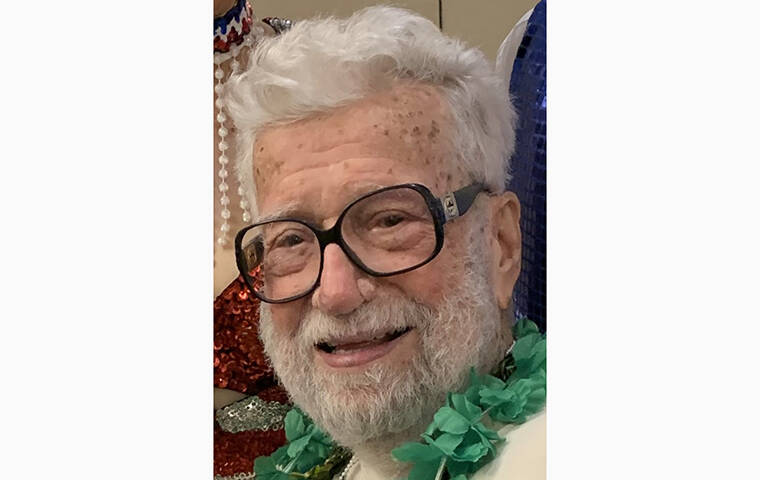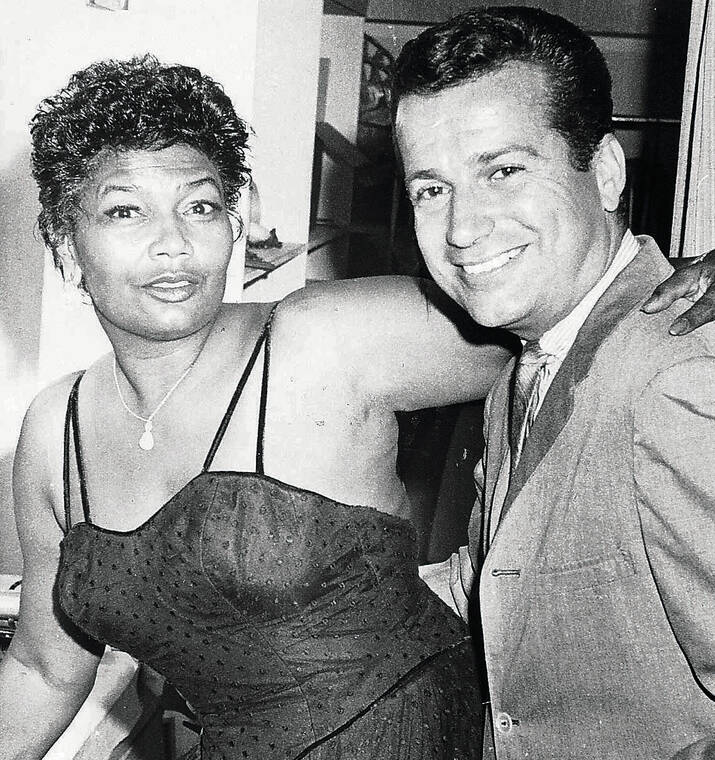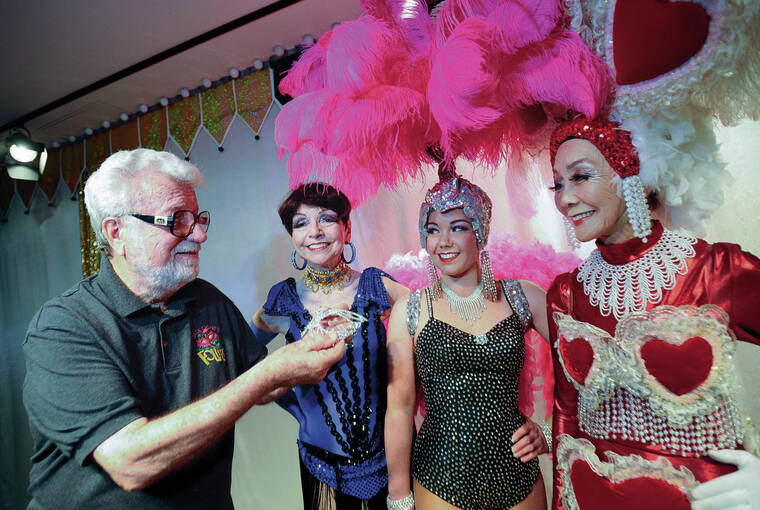Multitalented entrepreneur Cione redefined Hawaii entertainment

STAR-ADVERTISER
Jack Cione

COURTESY PHOTO / 1968
Above, Cione with Pearl Bailey.

STAR-ADVERTISER
Jack Cione started the “Arcadia Follies” when he moved into the Arcadia Retirement Residence, recruiting the core performers from the women who lived there. Pictured above is Cione in 2014 with some of the cast: Marci Taylor-Kaneshige, left, Allyson Doherty and Elva Yoshihara. He produced the final edition of “Jack Cione’s Arcadia Follies” — “Jack Cione’s Copacabana” — for a five-show run in September.



His willingness to let the people of Hawaii see whatever prudish public officials said should not be seen made him a legend in Hawaii’s entertainment history. His belief that it was better to do something and ask forgiveness than to ask permission and be denied was legendary as well. Jack Cione — entrepreneur, nightclub and showroom owner, cabaret show producer, dance instructor, author and creator of Hawaii’s original naked waiters revue — died Oct. 1 in Honolulu. He was 97.
Jack Cione, born Jack Cioni, grew up in a family of conservative Roman Catholic Italians in a small town outside of Chicago; an uncle with ties to organized crime discovered that Cioni could play the piano boogie- woogie style and got him a job playing piano in a Chicago nightclub at age 14.
Cioni’s success as a nightclub piano player proved detrimental to his performance in school. When one of his teachers said he was going to be a bum if he didn’t get better grades, Cioni retorted that he was making twice as much a week playing piano as she was making teaching school. That ended his high school education.
The high school dropout helped his parents move to Arizona in 1946, changed his name to the less ethnic “Cione” and went to Hollywood to become a movie star. He passed only one movie audition, but a chance meeting with Bob Hope got him a job touring with Hope for the USO.
Back in Hollywood, Cione ran out of money. He returned to Arizona and got a job as a dance instructor at the local Arthur Murray Dance Studio. It was the start of a career that would take him to New York — where he worked as an instructor and stage performer — and then back to Arizona where he developed a chain of dance studios.
It was also in Arizona that Cione began producing a local television variety show. From there he began developing and producing nightclub stage shows — initially for showrooms in Phoenix, and then in Las Vegas.
Don't miss out on what's happening!
Stay in touch with breaking news, as it happens, conveniently in your email inbox. It's FREE!
Cione was on his honeymoon, en route from Fiji to Tahiti, when a desire for American food prompted a detour to Hawaii. The newlyweds stayed for a week, then for a month. Cione was looking for something to do when he walked into an almost empty Honolulu nightclub and saw a show that he’d describe years later as one of the worst he’d ever seen. The owner agreed it was bad and asked Cione whether he could do something better. Cione replied that he could and would — and that he would do it for free because he needed something to do.
The show was a hit. Entertainment in Hawaii would never be the same.
From the beginning Cione enjoyed pushing the envelope when it came to costuming. Whatever the norm might be, Cione’s performers wore less and showed more. Arrests for “obscenity” — he was never convicted — were good for business. So were the letters to the editor written by “concerned citizens” who were complaining sight- unseen about whatever his newest outrageous show happened to be.
Cione couldn’t have paid for more effective advertising.
For many years Cione’s flagship operation was the Dunes, a multivenue building near the airport. There was a showroom where he presented national Las Vegas-caliber entertainers, and smaller rooms targeted other audiences. Cione would have soul music in one of them, country music in another, strippers somewhere else — and a squad of large doormen on hand just in case members of various groups clashed.
Cione’s presence in the island entertainment business became even bigger in the late 1970s when he created a new showroom, Le Boom Boom, for a vibrant new show, “Follies Polynesia,” in the International Market Place.
Cione built the show around a collection of beautifully extravagant showgirl costumes that were more Las Vegas than Waikiki — except for the fact that his “girls’” costumes covered their breasts. Cione also made news with his choice for the show’s headliner: Prince Hanalei had been known for years as the star of the Glade Show Lounge, the center of mahu culture on Hotel Street in Chinatown.
At Le Boom Boom the very masculine Prince Hanalei would come out on stage dressed like the Kamehameha statue. After an impressively choreographed performance ruling over a squad of dancers costumed as Kamehameha’s subjects, Hanalei would strip down to a G-string for a solo performance that he ended standing on his head and twirling burning tassels on his buttocks.
Visitors had never seen anything like it. Hanalei and the “Follies Polynesia” were an instant hit.
Shrewd businessman that he was, when Cione saw there was an empty disco at a nearby hotel, he filled it with a “Follies” spinoff show, “Oriental Fantasy.”
Elvis impersonators were big business in the late 1970s, and Cione cornered the Elvis impersonator market in Hawaii. When interest in Elvis impersonators began to wane, Cione presented three Hawaii residents in a three-Elvis show. One was a sincere Elvis fan who did his best to look and sound like Elvis; the fact that he was Japanese American made this difficult even though he performed wearing sunglasses. The second was a minimally talented veteran of the local bar band circuit who had no apparent affinity with Elvis, but would sing anything as long as he was getting paid. The third “Elvis” was the Le Boom Boom light operator performing with a bag over his head as the “Unknown Elvis” — a parody of the Unknown Comic, the comedian who had invented the bag-over-the-head bit.
Cione’s biggest claim to fame internationally were his naked waiters. The idea of naked male waiters serving tables at the Dunes had its origins in the days when Cione presented a popular businessmen’s lunch staffed with bare-breasted “topless waitresses.” When topless waitresses seemed to be losing their commercial appeal, Cione switched to naked waitresses — no clothes at all.
Then Cione heard from the businessmen’s female staffers that they were tired of being dragged to office lunches at the Dunes and being confronted with naked women. Where were the naked men? Cione saw a new market to serve and created the “Naked Waiters” luncheon show.
The naked waiters were another instant hit.
It was only then, when the naked performers were male, that the Honolulu Liquor Commission decided that naked performers must at all times be on a stage at least 18 inches high. Cione responded by having his naked waiters wear aprons — and if some of the women in the audience were lifting the aprons to see what was underneath, well, don’t blame him! The Dunes emcee would remind the women several times during lunch that they must never, repeat, never lift the waiters’ aprons! Many women took the hint. Some of the waiters made it easier for the women to see what they were there for by wearing their apron sideways.
When the time was right, Cione moved the naked waiters into Waikiki so that tourist women could share the experience. He also licensed the show to promoters in other markets, and wrote his first book, “What Do You Say to a Naked Waiter?”
Years later, when the Chippendales seminude male strip show was the new “big thing,” Cione brought in a seminude male stripper revue. Reasoning that women would feel more relaxed if there were no men in the audience, but not wanting to be charged with sex discrimination by barring men, Cione generated more publicity by setting the cover charge for men so high that no man ever insisted on paying it.
In 2014 he wrote a second book, an autobiography titled “Repotting Can Be Such a Bitch.”
Cione gradually retired from nightclub ownership but continued to be involved in entertainment. He taught tap dancing at the Waikiki Community Center and recycled many of his “Follies Polynesia” and “Oriental Fantasy” costumes in the G-rated “Mardi Gras Follies” he created and directed as a fundraiser for the Pearl Harbor Performing Arts Association for more than two decades.
“Mardi Gras Follies” became “Arcadia Follies” after Cione moved into the Arcadia Retirement Residence with the core performers of the show being recruited from among the women who lived there. He produced the final edition of “Jack Cione’s Arcadia Follies” — “Jack Cione’s Copacabana” — for a five-show run in September.
Funeral observances are pending.



